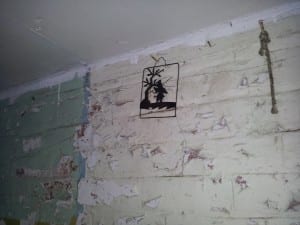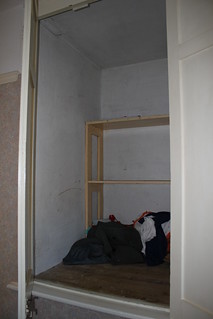The Garden Shed is “an attempt to create a separate world within a world, over which we have control and the means not only to imagine but to shape” (( Heathcote, Edwin (2012) The Meaning of Home, London: Frances Lincoln, p. 114 )) .

Man has always sought refuge, originally from the elements, building huts over which he had complete control, more recently as huts developed into homes these became the domain of the woman, be it the matriarch or the housewife. The man required refuge from the home itself, an inner sanctum, for some this is the office or the study, but for the everyday man a slapdash construction of corrugated iron and broken down fence panels could become a shrine to all things masculine, a place “for retreating into and thinking” (( Heathcote, Edwin (2012) The Meaning of Home, London: Frances Lincoln, p.115)).

Our sheds stand opposite each other almost mirror images. Their measurements are almost identical a square of concrete 6ft X 6ft for a floor, a single window facing out onto the shared courtyard, a large porcelain basin against the wall that stands on two pillars bare brick like the walls.
Everywhere the sure signs of decay, chipped and peeling paint, years of dust and cobweb are mingled with long dead insects and their living relatives. These sheds do also have their own individual characteristics which distinguish them and their former inhabitants, show the inescapable signs of practical minds in these confined spaces.
Shed A (named solely because it is almost always the first seen) is a bright space, full of the marks of human habitation, the slightly shoddy handmade shelves show a man more interested in function than design, further evidenced by the range of colours that can be seen on the walls. Most interestingly there are pencil marks recording long forgotten measurements for some project or other. These reveal the workings of a practical man, one of precision and detail, the man who builds.
Which brings us to an interesting stand point, the perceptions of man, there has for some time been a dichotomy in the perception of the masculine and inherent contradiction whereby the male creature is equally expected to be builder, protector and all round knight in shining armour and at the same time being suspected a pervert, peeping tom and general sexual deviant.
It occurs to me that this contradiction, and these extremes are incompatible and a solution must be found to reconcile them. It does equally occur to me that a reasonable person is capable of comprehending that to a certain degree these traits exist in all men and equally in all people, but performers are by and large not reasonable people, so I think it’s about time we took these two extremes the peeping tom and handy man and the various materials of their trades/hobbies/perversions locked them all in a room for 16 hours and see what we can be built, what can be corrupted, and where is the balance? If sheds are “Spaces we construct in which to dream” ((Heathcote, Edwin (2012) The Meaning of Home, London: Frances Lincoln, p.114)) what shape will this dream take? These are some big questions and will probably require some further thought, so I’ll be in the shed if you need me.

